When you think of Venice, you probably picture its canals, bridges, and romantic gondola rides. It’s a dream destination for many, and it’s easy to see why.
But even in such a perfect city, things can get crowded and hectic. That’s why choosing the best time to visit Venice is a half-guarantee to an amazing experience in Italy. This guide will break down the weather and travel conditions month by month, so you can pick the perfect time to visit!
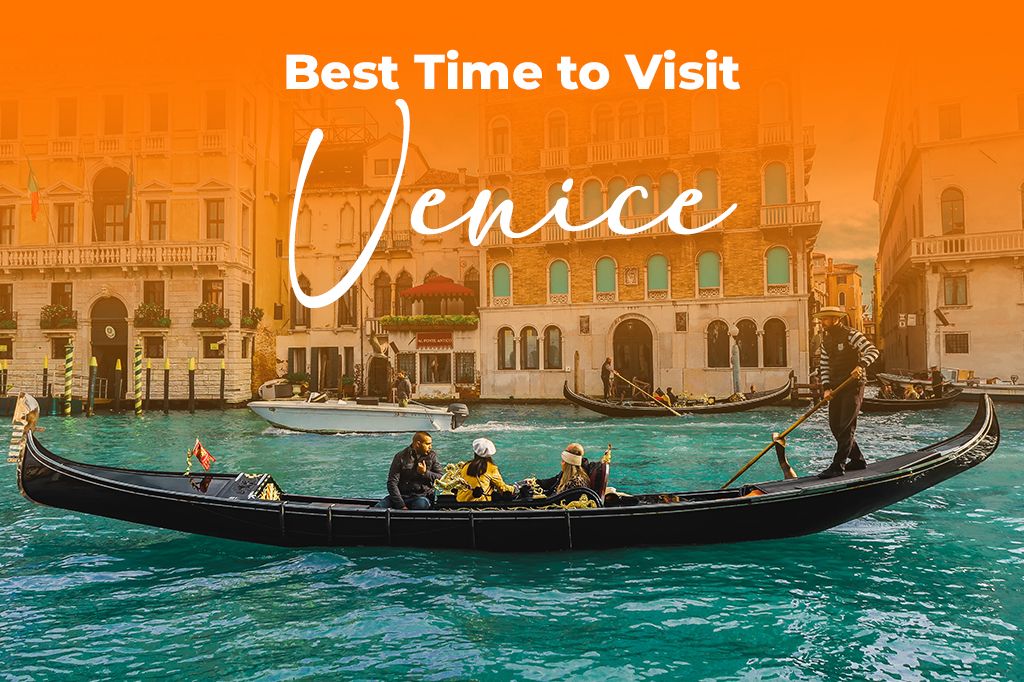
Picture by adrian krajcar on Unsplash
Best and Worst Times to Go to Venice, Italy: A Month-by-Month Guide
Venice, Italy, is a dream destination, a great place to visit, without any doubt. It is famous for its canals, historic buildings, and romantic aura. But when is the best time to visit? The answer depends on what you’re looking for. Do you want perfect weather, fewer crowds, or lower prices? Here’s a season-by-season breakdown to help you plan your trip.
Best Time to Visit Venice: Spring
Spring is probably the best time to visit Venice, with mild temperatures ranging between 15°C and 22°C (59°F to 72°F). The city begins to bloom with color, the days are longer and the canals reflect the season’s beauty. While the number of tourists rises, it’s still manageable compared to peak summer. You might get a little rain, but overall, it’s a great time to visit Venice. It’s a great time to explore the city, walk along its historic streets, or take a gondola ride through the canals.
This is a lovely time to visit because flowers like wisteria bloom along the canals, and the city’s gardens are filled with beautiful colors. The local food scene is also great, with fresh fruits, vegetables, and seafood sold at markets. You can enjoy delicious meals at outdoor cafés, especially when the weather is nice. Plus, since it’s less crowded than in the summer, you can enjoy the city more peacefully.
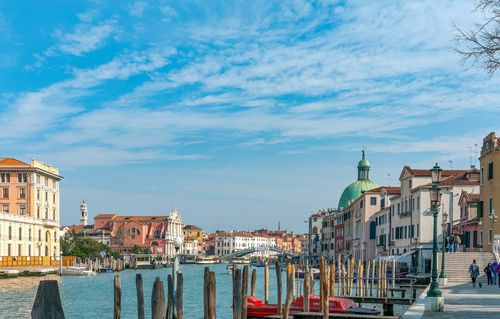
Spring Events and Activities to Follow in Venice
In spring, Venice comes alive with events like the Festa della Sensa in May, which celebrates the city’s long history with the sea, and the Festa di San Marco on April 25th, honoring Venice’s patron saint. La Biennale di Venezia, which starts in May some years, features art from around the world.
What’s the weather like during spring in Venice?
March: In March, the weather starts to warm up a little, with temperatures ranging from 5°C to 12°C (41°F to 54°F). There’s some rain, but it’s less frequent than in the winter.
-
Pros: It’s quieter than the peak season, with lower prices. You can also catch the end of the Venice Carnival. Spring begins to show, and the city feels more lively.
-
Cons: The weather can still be chilly and unpredictable, and flooding can still happen.
April: April is a good time to visit Italy because the weather is mild. Temperatures range from 9°C to 15°C (48°F to 59°F), so it’s not too cold or hot. You’ll have more sunny days and less rain compared to other months.
- Pros: Comfortable temperatures, fewer tourists than in summer, and gardens start blooming. A good time for outdoor activities and sightseeing.
- Cons: Rain is still possible, though less common. Attractions may be quieter but start getting busier towards the end of the month.
May: In May, Italy’s climate is generally warm, with temperatures between 12°C and 18°C (54°F to 64°F). It’s mostly sunny, but there might be some short rain showers.
- Pros: Great weather for sightseeing, mild temperatures, and flowers in bloom. The tourist season starts, but it’s not too crowded yet.
- Cons: It can get a bit busy as the season kicks off. There might be some short rain showers.
Venice’s Peak Summer Season
Venice in the summer is beautiful but very crowded. The weather is warm, ranging from 18°C to 30°C (64°F–86°F). This is the most expensive time to visit Venice and Italy too because hotels and flights cost more.
While the longer days and events make for a magical experience, you’ll also deal with packed streets, long lines, and very humid weather. If you go in summer, book your hotel early and try to explore in the early morning or late evening to avoid the biggest crowds.
In addition, summer in Venice aligns with major cultural events, such as the Biennale, where you can experience contemporary art exhibitions. It’s also a great time to visit museums and explore temporary art shows, giving you the chance to delve into the city’s rich cultural heritage.
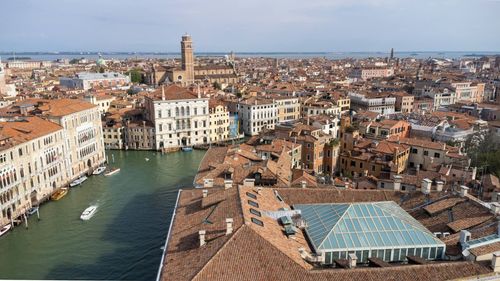
Summer Events and Activities to Follow in Venice
Summer in Venice is an exciting time to visit to attend festivals such as The Festa del Redentore in July, featuring fireworks and boat races, and the Regata Storica with colorful boat parades and competitions. The warm weather is also ideal for gondola rides through the city’s canals, where you can enjoy beautiful views of landmarks like the Rialto Bridge and Grand Canal.
What’s the weather like during summer in Venice?
June: In June, the weather is warm to hot, with temperatures between 17°C and 24°C (63°F to 75°F). It’s mostly sunny in Venice, Italy, and there’s not much rain.
- Pros: Great weather for outdoor activities like walking tours, gondola rides, and visiting attractions. Days are longer, and the nightlife is lively.
- Cons: It marks the beginning of the busy tourist season, so expect more crowds and higher prices. It can also get quite hot in the afternoons.
July: In July, the weather is hot, with temperatures between 21°C (70°F) and 30°C (86°F). It’s usually dry, but very humid.
-
Pros: The days are long and sunny, making it perfect for outdoor events and festivals.
-
Cons: It gets very crowded with tourists, and hotel prices are high. The heat and humidity can be uncomfortable, especially during the hottest parts of the day. In some areas, there might be flooding (called Acqua Alta).
August: In August, Venice is very hot, with temperatures between 21°C (70°F) and 29°C (84°F), and it feels humid, with little rain.
-
Pros: The weather is great for enjoying outdoor activities like walking around the city, exploring the canals, and attending events.
-
Cons: It’s the busiest time for tourists, so places are crowded, and prices for things like hotels and attractions are higher. The heat and humidity can be exhausting, and some locals are on vacation, making the city feel a bit quieter in some areas, though still crowded with tourists.
Shoulder Season or Fall in Venice
Autumn in Venice is also another great time to visit because the weather is still nice, and there are fewer tourists. Temperatures range between 10°C and 18°C (50°F to 64°F), so it’s not as hot as summer. There are fewer tourists, making it easier to enjoy famous sights like St. Mark’s Basilica and the Rialto Bridge without the big crowds.
October is the best month, as the weather is still nice but with fewer people. In November, you might even see mist, which adds a mysterious feel to the city.
However, fall is also when flooding (acqua alta) can start, so if you’re visiting later in the season, check the weather and bring waterproof clothes.
In Venice, during the fall and winter (from October to January), there are occasional events called "Acqua Alta" or "high water," where the city experiences higher-than-usual tides. This doesn't happen all the time, but when it does, it can cause flooding that might mess with your travel plans. To be ready for it, it's a good idea to bring waterproof gear and check flood forecasts before you go.
Fall makes Venice a more romantic and peaceful place to visit. With fewer tourists, you can enjoy the city’s beautiful streets and canals at a relaxed pace. The warm, golden colors of the season create a stunning atmosphere. It’s also the perfect time for a romantic gondola ride, as the canals are quieter and gondoliers even provide blankets for warmth.
Did you know that Venice has more than 500 beautiful gardens? They look especially gorgeous in early autumn when the leaves change color. Some of these gardens, like Giardini di Castello and Giardini Papadopoli, offer peaceful spots for visitors to enjoy. During this time, most popular tourist attractions like museums and galleries are less crowded, so visitors don’t have to wait in long lines as they would in the busy summer months.
During this season, Venice becomes a great place to visit because the weather is pleasant, prices are lower, and there are fewer tourists. This makes it easier to enjoy the city like a local and explore without the usual crowds. With the money saved on things like hotels and activities, travelers might even be able to stay longer than they would in peak season. It’s a wonderful opportunity to see Venice more discreetly.
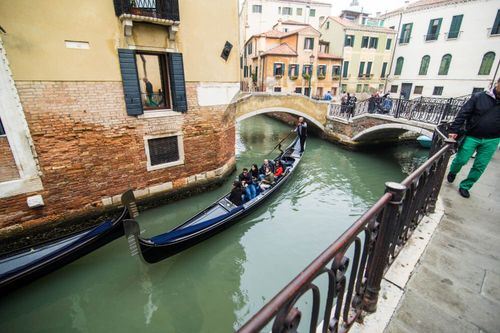
Image by diana.grytsku on Freepik
Fall Events and Activities in Venice
Autumn in Venice is filled with exciting events and delicious food. Starting in late August and continuing through early October, there are festivals like the Venice International Film Festival, Venice Glass Week, Venice Cocktail Week, Venice Design Week, and Venice Fashion Week. These offer a variety of cultural experiences for visitors.
Along with these events, the season also brings a chance to enjoy tasty autumn dishes such as risotto with cuttlefish ink, local appetizers called cicchetti, and fresh seasonal produce from nearby islands like Sant’Erasmo. It’s a great time for both entertainment and food lovers!
When visiting the beautiful city of Venice, Italy, it’s important to stay connected and informed.
One way to easily access real-time local information and stay in touch with friends is by using a Yoho Mobile’s free eSIM trial and get instant access to mobile data in over most countries. No SIM card, no contracts—just a quick setup and you’re online in minutes.
If you want to get your eSIM plan afterwards, use the code YOHO12 at checkout for a 12% discount!
What’s the weather like during fall in Venice?
September: In September, the weather in Venice is warm and comfortable, with temperatures between 17°C (63°F) and 24°C (75°F). There’s less rain and the humidity is manageable.
-
Pros: It’s a great time to visit because the weather is perfect for sightseeing, and there are fewer tourists compared to the busy summer months. The Venice Film Festival also takes place, which adds a cultural experience to your trip.
-
Cons: Prices are a bit higher because some summer tourists are still around, although the crowds are starting to shrink. Popular areas, especially during big events, can still be crowded.
October: The weather during October in Venice, is generally mild, with temperatures between 12°C and 18°C (54°F to 64°F). It might rain a little, but there’s still a lot of sunshine.
-
Pros: The weather is quiet and pleasant, with fewer tourists and lower prices than in the summer. The city looks beautiful with autumn colors and mild temperatures.
-
Cons: Rain is more likely as the month goes on, and some attractions may have shorter hours.
November: In November, Venice has a cool climate, with temperatures between 6°C and 12°C (43°F to 54°F). It often rains, and fog can make the city look mysterious.
-
Pros: There are fewer tourists, so it’s quieter and less crowded. Prices are lower, making it a good time to explore Venice without the hustle and bustle.
-
Cons: The weather is cold and rainy, with more flooding (Acqua Alta). Because of this, outdoor activities may be limited.
Is Winter the Worst Time to Visit Venice?
Visiting Venice in winter can be nice because it’s quieter and more peaceful with fewer tourists. The city is charming during this time of year. However, it might be the worst time to visit Venice because the weather is cold and damp (between 0°C and 10°C, or 32°F to 50°F) and often foggy, and many places, like restaurants and attractions, might not be open as long. There’s also a chance of flooding, which can make it harder to explore.
On the plus side, popular sights like Doge’s Palace are less crowded in winter, so you don’t have to wait long to see them. If you enjoy festive events, you canattend the Venice Carnival in February with its fun masks, costumes, and celebrations. Since it’s the off-season, traveling during winter is usually cheaper, which is great for those on a budget who can handle the chilly weather.
Winter season in Venice brings special sights, like snow that makes the city look magical, and a rare event called “acqua bassa” (low water), which lets you see parts of Venice’s buildings that are usually hidden by the tide.
"Acqua bassa" in Venice, meaning low water, is exciting for sightseeing, but it can make getting around more difficult. On the good side, it reveals parts of the city's buildings and structures that are usually hidden underwater, giving visitors a unique chance to see and photograph them. However, it can also cause problems by exposing muddy areas or making it harder for boats and water transport to move around, which can disrupt daily activities.
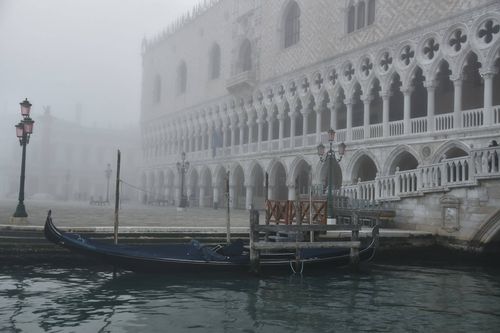
Events and Activities to Follow During Winter in Venice
Winter in Venice offers some unique and exciting events. The Carnevale di Venezia is a famous carnival where you can make masks and enjoy festive celebrations.
On January 6th, the Regata delle Befana takes place, featuring a fun boat race where participants dress up as La Befana, a folkloric witch.
During Christmas and New Year’s, the city hosts activities like an ice rink, fireworks, and special events such as a candlelit Christmas mass. These events make Venice a superb destination during the winter season.
What’s the weather like during winter in Venice?
December: In December, the weather in Venice is cold, with temperatures between 3°C and 8°C (37°F to 46°F). It can rain sometimes, and you might notice more fog.
-
Pros: It’s a lovely time to see Christmas markets, and lights, and enjoy a cozy atmosphere. There are fewer tourists and prices are lower than in the summer.
-
Cons: The weather is chilly, and there’s a chance of flooding (called Acqua Alta). Some outdoor activities might not be possible, and some attractions might be closed or have shorter hours.
January: January is cold, with temperatures between 1°C and 7°C (34°F to 45°F). It’s winter, with occasional rain and fog.
- Pros: Fewer tourists, lower hotel prices, and a quieter atmosphere. You can enjoy Venice without the crowds.
- Cons: Cold weather, possible flooding (Acqua Alta), and fewer outdoor activities. Some attractions might have shorter hours.
February: In February, Venice’s weather is cold, similar to January, with temperatures between 2°C and 8°C (36°F to 46°F). Venice often has rain and fog.
- Pros: Venice Carnival offers a special cultural experience with masks and parades. Fewer tourists when it’s not Carnival time.
- Cons: Cold, wet weather, possible flooding, and limited outdoor activities. Crowded during Carnival.
What You Need to Know Before Visiting Venice
Visiting Venice is a special experience, but to really enjoy it, it’s helpful to know some expert advice that can make your trip even better:
-
Get around by foot or water: Venice is best explored on foot, but if you need to cover longer distances, use water buses (vaporetti). The #2 Vaporetto offers great views of the Grand Canal.
-
Use offline maps: Streets in Venice can confuse GPS, so download offline maps before your trip. Apple Maps usually provides better walking directions than other apps.
-
Stay near St. Mark’s or in Mestre: If it’s your first time in Venice, stay near St. Mark’s Square for easy access to major attractions. Alternatively, staying in Mestre is a cheaper option on the mainland with good transport links to Venice.
-
Get a Museum Pass: If you’re visiting multiple museums, consider getting a museum pass for access to several civic museums. Don’t miss highlights like the Accademia and Scuola Grande di San Rocco.
-
Try local dishes: Be sure to try local dishes like cicchetti (Venetian tapas), Italian desserts, and delicious gelato. To avoid overpriced meals, dine away from the tourist-heavy areas.
-
Explore Venice by night: Venice is safe at night, so take advantage of evening walks along its canals or attend a classical music concert in one of its churches.
-
Bring Cash (Euros): Make sure to bring cash (Euros), as smaller stores and local businesses in Venice often prefer it or may not accept credit cards.
-
Share a Gondola Ride to Save Money: A gondola ride is a classic Venetian experience, but it can be pricey. To cut costs, consider sharing the ride with fellow travelers, making this unforgettable experience more affordable.
-
Stay connected while you travel—try Yoho Mobile’s free eSIM trial and get instant access to mobile data in over most countries. No SIM card, no contracts—just a quick setup and you’re online in minutes. If you want to get your eSIM plan afterwards, use the code YOHO12 at checkout for a 12% discount!
FAQs on Traveling Venice in Italy
When is The Best Time of Year to Go to Venice, Italy?
The best times of year to visit Venice are in spring and fall. During these months, the weather is pleasant, there are fewer tourists, and hotels are more affordable.
It’s best to avoid visiting in the summer because it’s hot and crowded. If you go in March or December, you’ll still enjoy decent weather and fewer people, plus you can attend special events like Carnival or Christmas celebrations.
Overall, Venice is beautiful at any time, but visiting at the right time will help you get the most out of the experience.
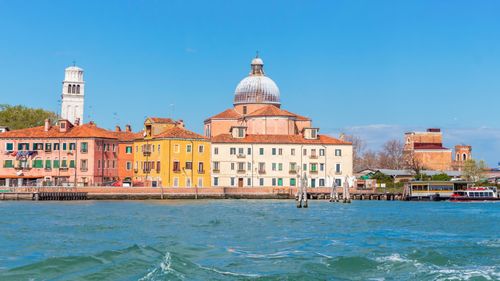
Image by frimufilms on Freepik
When should you avoid visiting Venice?
It’s best to avoid the summer months, especially July and August, as they are crowded with tourists, making it hard to truly enjoy the city. Hotel, food, and tour prices go up, and the weather is hot and humid, especially by the canals. You may also face long waits at attractions and the risk of flooding, known as “Acqua Alta.”
For a more relaxed visit, visit Venice in spring or fall when the weather is milder, and there are fewer crowds.
What are the best seasons for outdoor activities in Italy?
The best times for outdoor activities in Italy are spring (April to June) and fall (September to October). Spring has mild weather and blooming landscapes, making it great for hiking in the Alps, exploring Tuscany’s vineyards, or cycling along the Amalfi Coast. Fall offers crisp air and beautiful foliage, ideal for trekking in the Dolomites or countryside drives, especially as it’s grape harvest season. Both seasons have good weather, fewer crowds, and an opportunity to enjoy Italy’s natural beauty.
What is the most expensive time to go to Italy?
The most expensive time to visit Italy is in the summer, from June to August. During these months, Italy is busy with tourists visiting popular spots like Rome, Venice, Florence, and the Amalfi Coast. The warm weather, long days, and festivals attract many travelers, but this also raises prices for hotels, flights, and tours. Attractions can be crowded, and hotel prices are high, especially in major cities and popular areas.
For a more affordable trip, visit in the spring (April to June) or fall (September to November), when prices are lower, and the weather is still pleasant.
Does it get cold in Italy?
Yes, Italy can get quite cold, especially in the winter in the north, like the Alps and Po Valley, where temperatures often drop below freezing, with snow and ice from December to February. Cities such as Milan, Turin, and Venice have also cold winters, with temperatures usually below 0°C and occasional snow. In central and southern Italy, including Rome and Naples, and coastal areas like Sicily and Sardinia the winters are milder, and stay relatively warm, rarely dropping below 10°C (50°F).
While Italy doesn’t get extremely cold overall, it can still be chilly, especially in the mountains and inland areas.
Is Venice worth visiting?
Yes, Venice is definitely worth a visit! Venice is a must-visit because it’s a one-of-a-kind city with beautiful canals, amazing buildings, and a lot of history. Some must-see places and experiences include the Grand Canal, St. Mark’s Square, the Rialto Bridge, and taking a gondola ride. It’s also known for its art, museums, and events like the Venice Film Festival and Carnival.
